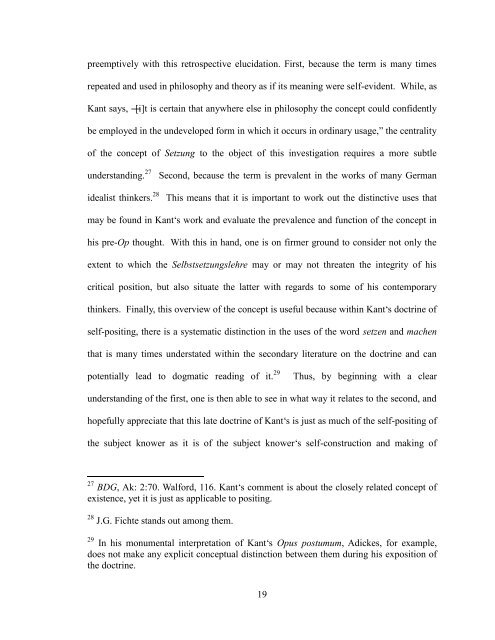The Doctrine of Self-positing and Receptivity in Kant's Late ...
The Doctrine of Self-positing and Receptivity in Kant's Late ...
The Doctrine of Self-positing and Receptivity in Kant's Late ...
Create successful ePaper yourself
Turn your PDF publications into a flip-book with our unique Google optimized e-Paper software.
preemptively with this retrospective elucidation. First, because the term is many times<br />
repeated <strong>and</strong> used <strong>in</strong> philosophy <strong>and</strong> theory as if its mean<strong>in</strong>g were self-evident. While, as<br />
Kant says, ―[i]t is certa<strong>in</strong> that anywhere else <strong>in</strong> philosophy the concept could confidently<br />
be employed <strong>in</strong> the undeveloped form <strong>in</strong> which it occurs <strong>in</strong> ord<strong>in</strong>ary usage,‖ the centrality<br />
<strong>of</strong> the concept <strong>of</strong> Setzung to the object <strong>of</strong> this <strong>in</strong>vestigation requires a more subtle<br />
underst<strong>and</strong><strong>in</strong>g. 27 Second, because the term is prevalent <strong>in</strong> the works <strong>of</strong> many German<br />
idealist th<strong>in</strong>kers. 28 This means that it is important to work out the dist<strong>in</strong>ctive uses that<br />
may be found <strong>in</strong> Kant‘s work <strong>and</strong> evaluate the prevalence <strong>and</strong> function <strong>of</strong> the concept <strong>in</strong><br />
his pre-Op thought. With this <strong>in</strong> h<strong>and</strong>, one is on firmer ground to consider not only the<br />
extent to which the Selbstsetzungslehre may or may not threaten the <strong>in</strong>tegrity <strong>of</strong> his<br />
critical position, but also situate the latter with regards to some <strong>of</strong> his contemporary<br />
th<strong>in</strong>kers. F<strong>in</strong>ally, this overview <strong>of</strong> the concept is useful because with<strong>in</strong> Kant‘s doctr<strong>in</strong>e <strong>of</strong><br />
self-<strong>posit<strong>in</strong>g</strong>, there is a systematic dist<strong>in</strong>ction <strong>in</strong> the uses <strong>of</strong> the word setzen <strong>and</strong> machen<br />
that is many times understated with<strong>in</strong> the secondary literature on the doctr<strong>in</strong>e <strong>and</strong> can<br />
potentially lead to dogmatic read<strong>in</strong>g <strong>of</strong> it. 29 Thus, by beg<strong>in</strong>n<strong>in</strong>g with a clear<br />
underst<strong>and</strong><strong>in</strong>g <strong>of</strong> the first, one is then able to see <strong>in</strong> what way it relates to the second, <strong>and</strong><br />
hopefully appreciate that this late doctr<strong>in</strong>e <strong>of</strong> Kant‘s is just as much <strong>of</strong> the self-<strong>posit<strong>in</strong>g</strong> <strong>of</strong><br />
the subject knower as it is <strong>of</strong> the subject knower‘s self-construction <strong>and</strong> mak<strong>in</strong>g <strong>of</strong><br />
27 BDG, Ak: 2:70. Walford, 116. Kant‘s comment is about the closely related concept <strong>of</strong><br />
existence, yet it is just as applicable to <strong>posit<strong>in</strong>g</strong>.<br />
28 J.G. Fichte st<strong>and</strong>s out among them.<br />
29 In his monumental <strong>in</strong>terpretation <strong>of</strong> Kant‘s Opus postumum, Adickes, for example,<br />
does not make any explicit conceptual dist<strong>in</strong>ction between them dur<strong>in</strong>g his exposition <strong>of</strong><br />
the doctr<strong>in</strong>e.<br />
19


